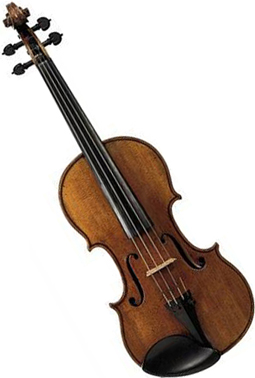Contents:

#1: Violin
Important info:
Played by: Bow
Key: Concert Pitch
Clef: Treble
Tuning:
Range:
With it having the highest range, the violin can be considered to be the soprano of the string section. Its strings are tuned to specific pitches and these pitches are called Ďopen notesí. This is the pitch that is heard when string is played with no fingering. Image #2 shows the violins tuning, from the forth (IV) string (lowest) up to the first (I) string (highest).
It is important to remember at this point that there are certain pitches which can only be played on the I. This is when the notes on the lowest string havenít reached up to the pitch of the next string. This is only really needed to no when double stopping is being used.
Double-stopping
Double-stops can be a very useful technique to use, but not all double-stops can be possible on the violin. Double-stops are played on two strings that are directly next to each other. This means the pitches that are required in the double stop must be available on both strings.
Using open strings
If you can use an open string in double-stops it is very easy to perform wide intervals. If you are using the lowest string as the open string then the smallest interval you can double-stop is perfect fifth, this is done by using both strings as open, for example the G and D. The intervals can be as wide as you like as long you stay within the limits of the string.
If you wanted to use, for example both the G and D string and keep the D string as the open string, then you can use the G string to play a minor second below the D right down to a perfect fifth. The G string can play notes higher than the open D note as well as doubling the note itself, so a wide interval above D is also available. This is true for all the strings on the violin.
Fingering both strings
This makes wider intervals a bit more difficult. First of all the performer has to be able to put down a finger on both strings to be able play the notes in the double-stop; this makes wider intervals more difficult for the performer to perform. The intervals are really limited by how far and how comfortable the stretch is for the performer, so talk to a performer to see whatís possible. Also the lower the notes in the double-stop, the wider the stretch may be. The same interval an octave higher will have a smaller span than one lower. A safe guide line would be from a tone apart to an octave.
Triple/Quadruple-stops
It is not really possible or practical to play more than two strings when stopping so when triple and quadruple-stops are required the performer will rock the bow across the strings causing an arpeggio type effect landing on the top two strings as in double-stop.
When writing triple and quadruple-stops, donít write the intervals too wide apart as the performer may have to finger up to four different strings.
Also make sure that each note of the chord is playable on a different string to the rest of them. You can only play one note per string at any one time. Back to top
Db/C#
Gb/F#
B
E
C
F
Bb/A#
Eb/D#
B
E
A
D
Bb/A#
Eb/D#
Ab/G#
Db/C#
A
D
G
C
Ab/G#
Db/C#
Gb/F#
B
G
C
F
Bb/A#
Gb/F#
B
E
A
F
Bb/A#
Eb/D#
Ab/G#
E
A
D
G
#2: First ten notes on each violin string

#3: Violin harmonic partials
Harmonics
It has already been explained on the Ďstringsí page how to achieve natural and artificial harmonics. Image #3 shows each partial for the four strings on the violin. Back to top